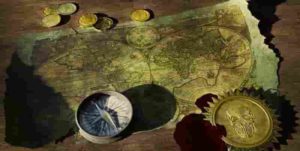Consider building an arcane trickster with these elements in mind:
- Choose a race with Dexterity/Intelligence bonuses
- Build a rogue with ranged weapons
- Learn Arcane Trickster skills: Mage Hand Legerdemain +
- Choose illusion and enchantment spells
- Don’t forget higher level rogue abilities
Arcane tricksters in Dungeons and Dragons 5e are thieves and pickpockets with a knack for illusion and enchantment magic. This type of character is more on the fun-loving side of the rogue class, considered a trickster or mischief-maker. However, I like the idea of a magic thief and treasure hunter. One of the main characteristics of this rogue is the unique use of the mage hand cantrip, allowing this rogue to pick pockets and locks from far away.
Before we dive in, why not try out your Arcane Trickster in a premade pirate campaign? Click here or below to learn more.
Choose a race with Dexterity/Intelligence bonuses
Dexterity and Intelligence will be key for this build—I’ll need Dexterity for Stealth and Intelligence for magic. Therefore, I’m thinking forest gnome and feral tiefling are my best choices.
Forest gnomes gain a +2 Intelligence/+1 Dexterity bonus combo, giving them an edge in casting spells and disappearing. I’ll gain minor illusion as a bonus cantrip, which is a fitting addition to my spell list, and the ability to speak to small animals. Plus, I’ll gain Gnome Cunning and get advantage on Intelligence, Charisma and Wisdom saving throws. Overall, this character leans into the mischief-making side of the arcane trickster.
Feral tieflings are a bit more ruthless, with innate spells like hellish rebuke and a +2 Dexterity/+1 Intelligence bonus combo. Hellish rebuke (level 3) is an innate 1-a-day spell cast as a 2nd level spell, meaning this deals 3d10 fire damage on a failed Dexterity save. Of course, this is only in retaliation to being hit, but still… ouch. I’ll also gain resistance to fire damage, as well as the thaumaturgy cantrip (level 1) and darkness once a day. Charisma will be the casting skill for these innate spells.
Build a rogue with ranged weapons
When playing this trickster roll, we should remember all the abilities gained from the basic rogue class and implement those skills as well. Our initial build choices should keep our play style in mind, so I’ll be sure to use a shortbow as my ambush weapon. This way, I can utilize stealthy rogue features and magical ranged abilities early on.
Related Posts:
Guide to Building a Monk Way of the Four Elements: DnD 5e
| Guide to Building a Rogue Thief: DnD 5e
|
Expertise doubles my proficiency bonus for 2 out of my 4 proficient skills. Overall, I’ll choose Acrobatics, Deception, Investigation and Stealth. However, I’ll choose my thieves’ tools proficiency along with Stealth like every other rogue I make for increased score. I still want to pick all the locks and unarm traps as a good rogue should.
Sneak Attack is my main combat feature, giving me additional damage when I hit an enemy with an attack roll that has advantage. In other words, if I can ambush my enemy, I’ll gain an extra 1d6 damage. This damage raises to 2d6 at level 3 and 3d6 at level 5. Even if I don’t play this character as some kind of assassin, I’ll have a combat maneuver ready for battle.
I’ll also begin with Thieves Cant, a secret language between rogues written in strange symbols.
When I reach level 2, I learn Cunning Action, which is a great way to set up my Sneak Attack. Cunning Action grants me a bonus action to Dash, Disengage or Hide. Therefore, I can maneuver around the chaos of a battlefield and attempt a Hide to gain advantage for my Sneak Attack bonus damage. Plus, I’ll be able to flee and use my magic or ranged attacks against aggressive opponents.
Learn Arcane Trickster skills: Mage Hand Legerdemain +
When I reach level 3, my arcane trickster subclass grants me magic from the wizard schools, especially illusion and enchantment. This subclass is built to be a truly magical rogue, blending elements of both in cunning ways.
Mage Hand Legerdemain is a major aspect of the arcane trickster—you could call them mage hand experts. This ability makes an arcane trickster’s spectral mage hand cantrip invisible and includes several benefits.
- I can stow an object into a container worn by another person—i.e. plant evidence or a nasty surprise on a foe.
- I can retrieve an object from a container worn or carried by another person—steal stuff.
- Finally, I can use my thieves’ tools from a distance, giving myself room for explosive traps.
I can perform these tasks without being noticed if my target fails a Perception (Wis) check against my Sleight of Hand (Dex) check. Now, I’m putting the trickster element in this class. This ability works well whether I’m exploring a dungeon or undercover at a party.
Magical Ambush gives my foes disadvantage against magic attacks made while I’m hidden. With this class, this often means charming or fooling targets with magical effects. This ambush gives us a great deal of creative solutions to solving problems, whether fooling a dangerous foe or charming an NPC.
Versatile Trickster (level 13) uses the mage hand cantrip to grant me advantage on attack rolls. I can cast mage hand as a bonus action. Then, I can choose any enemy within 5 feet of the spectral hand and gain advantage on an attack against them.
Spell Thief (level 17) gives me the ability to steal opponents’ spells when they attack me or include me in an area effect. The caster must make a saving throw with their spellcasting modifier against my Intelligence DC. On a failed save, I negate the effect against me and can cast it with one of my spell slots. This ability to copy the spell lasts for 8 hours.
Choose illusion and enchantment spells
An arcane trickster gains 3 cantrips and 3 1st-level spells at level 3, with 2 spell slots to cast these 1st level spells. Most of my spells will be based in enchantment or illusion magic schools. And, of course, mage hand has to be one of my cantrip choices.
Cantrips
Fortunately, I can choose my other 2 cantrips for this class, which offers me an opportunity to cast outside of the illusion and enchantment schools. With mage hand being so useful for adventuring, especially in this class, I’ll focus on combat options for my other 2 selections.
- Mage hand: Summon a spectral hand to perform tasks from a distance, such as opening doors, lifting small objects and all the special arcane trickster abilities.
- Ray of frost: I fire a ray of cold blue energy for 1d8 cold damage, reducing my opponents speed by 10 feet until my next turn. This offers me a ranged attack and enemy manipulation all in one cantrip.
- Minor illusion: Create a sound, small visual illusion or even smell to distract opponents or fool NPCs. This utility spell has many creative uses, especially when I’m trying to get the jump on someone.
1st-Level Spells
Like my cantrip choices, I’ll have plenty of fun adventuring spells built into my 1st-level spell options. Therefore, my free spell choice will be related to combat. Higher-level spells will need to come from the illusion or enchantment schools of magic.
- Silent Image: Illusion— Create an illusory silent object, creature or person no larger than a 15-foot cube. I can move this illusion around the field on my turn. Mostly, I’ll be creating copies of myself to confuse opponents. Think Naruto’s shadow clones.
- Charm Person: Enchantment—Charm a target if they fail a Wisdom saving throw. Target gains advantage on this saving throw if we are in the middle of combat. This spell is an arcane trickster classic and can be used inside and outside of battle.
- Earth tremor: Each creature within 10 feet of me must make a Dexterity saving throw or be knocked prone with 1d6 bludgeoning damage. If the ground is loose dirt or rock, it becomes difficult terrain that needs to be cleared. I think of this spell as an escape option that can also set up my Sneak Attack.
Related Posts:
Guide to Building a Forest Gnome Character: DnD 5e
| Zombie Apocalypse Guide: DnD 5e Pathfinder
|
Don’t forget higher-level rogue abilities
As my arcane trickster levels, I’ll gain spells at a casual rate—more of a flavor of magic than a full-blown magician. Therefore, I’ll lean into my higher-level rogue abilities and blend these features with my spellcasting.
- Uncanny Dodge allows me to use my reaction to half the damage I take from a melee attack. As far as staying alive is concerned, this is huge for me—Level 5.
- Evasion grants me the ability to take 0 damage on successful Dexterity saving throws for magical area effects, instead of half—Level 7.
- Reliable Talent allows me to treat a d20 skill check of 9 or lower as a 10. Meaning, I can’t roll anything less than a 10 before adding my modifiers. This only works for skills I’m proficient in—Level 11.
- Blindsense gives me the ability to sense creatures within 10 feet of me when in total darkness. Level 14
- Slippery Mind gives me proficiency with Wisdom saving throws. I’ll be the only one charming folks, thank you—Level 15.
- Elusive negates advantage on enemy attack rolls. Level 17
- Stroke of Luck is my final rogue option, giving me an automatic hit when I miss. This goes for combat or saving throws, and I must rest before I use it again. Level 20.






